| Columns Retired Columns & Blogs |
Cary SLP-98P tube preamplifier Measurements
Sidebar 3: Measurements
Once I had worked out how to get a signal to appear at its outputs—see AD's comments on the confusing switch labeling—the Cary SLP-98P preamplifier's phono stage offered a gain of 43.4dB (measured at the tape outputs) and an input impedance of 44.4k ohms, both appropriate for moving-magnet cartridges. The RIAA error is shown in fig.1: there is a very slight swayback apparent, reaching ±0.2dB, which will be just audible as a touch of enhanced image depth. More important, note the 0.9dB channel imbalance, which is presumably due to gain differences in the 12AX7 tubes used in the phono stage, and the fact that the RIAA correction conforms to the IEC bass rolloff, reaching -3dB at 20Hz. The Cary's channel separation (not shown) was better than 70dB below 4kHz, and was still 50dB at 20kHz, which is better than any phono cartridge.
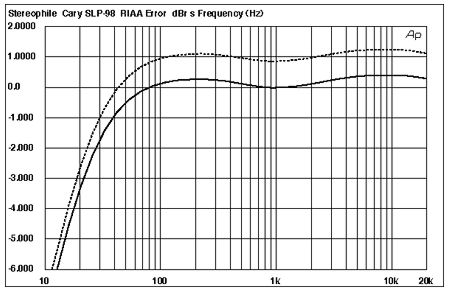
Fig.1 Cary SLP-98P, phono-stage RIAA error at 5mV input into 100k ohms, measured at the tape-out jacks (1dB/vertical div., right channel dashed).
The overload margin at 1kHz was excellent, at 22.6dB (ref. 5mV), and almost as good at 20Hz, at 18.1dB. However, it was less good at the high-frequency extreme: 10dB at 20kHz. This suggests that the Cary owner should steer clear of "hot" MM cartridges. On the other hand, the distortion content of the phono stage is almost pure second-harmonic in nature, which tends to be subjectively benign. It is also low in level, at around 0.1% (including noise). The signal/noise ratio itself was an excellent 74.1dBA (ref. 5mV input), though removing the A-weighting filter and extending the measurement bandwidth to 500kHz reduced this to a still good 52.6dB.
The SLP-98P's line stage inverts signal polarity and has a maximum gain of 21.1dB, higher than specified. The volume control's unity-gain setting was 11:00. The input impedance was a usefully high 45k ohms across most of the audioband, dropping to 36k ohms at 20kHz—still high enough not to present source components with any problems. The output impedance in the midrange and treble was usefully low, at 370 ohms, but this rose at 20Hz to 6.8k ohms, due to the limited size of the output coupling capacitors. This will prematurely and audibly roll off the bass with power amplifiers having an input impedance of much less than 20k ohms.
This can be seen in fig.2, which shows the line stage's frequency response under various conditions. The trace reaching a thin-sounding -3dB at 100Hz was taken into a low 1k ohm load. Increasing the load to 10k ohms—typical of a solid-state power amplifier—extends the bass to -3dB at 15Hz and -1dB at 30Hz, which might well be perceived as "tight"-sounding low frequencies. Note again a channel mismatch—0.4dB this time—though this can be trimmed out with the individual channel input-level controls. The preamp can be seen from this graph to have a wide bandwidth into the 100k ohm lab load, the -3dB point lying at at 200kHz, though this drops to 90kHz with the volume control at its unity-gain position. With just 0.25dB of rolloff at 20kHz, however, the reduction in bandwidth will have no subjective consequences.
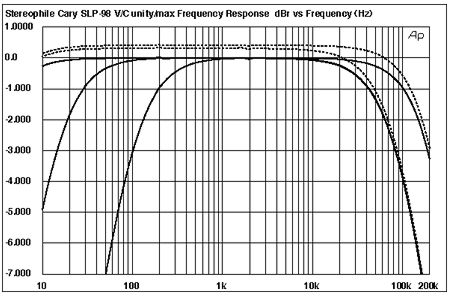
Fig.2 Cary SLP-98P, frequency response at 1V (from left to right) with volume control at unity gain into 100k ohms, 10k ohms, 1k ohm, and into 100k ohms with volume control at unity gain and at +21dB (1dB/vertical div., right channel dashed).
The SLP-98P's channel separation (not shown) was superb, at 110dB at 1kHz, this decreasing with increasing frequency, due to the usual capacitive coupling between channels, to a still-excellent 80dB at 50kHz. The line stage's S/N ratio was excellent for a tubed design offering a reasonable amount of gain. With the input shorted but the volume control wide open, the SLP-98P offered 94.6dB (A-weighted, ref. 1V output), with a still excellent unweighted audioband figure of 84dB. The unweighted wideband S/N ratio was 59.4dB, however, due to the presence of some ultra- and infrasonic noise.
Fig.3 shows how the percentage of THD+noise in the SLP-98's line-stage output changes with increasing output voltage into three different loads: 100k, 10k, and 1k ohms. The downward slope of the traces at the left of the graph indicates that the distortion products lie below the noise floor in this region. The preamp is obviously unhappy driving the low 1k ohm load, the distortion beginning to rise above 70mV output and reaching 1% THD at just 600mV. But a much higher voltage was available into the higher impedances: 16V! (I usually term the 1% THD voltage the "clipping point," but looking at the waveform on a 'scope as I performed this test revealed that only the bottom halves of the waveform were being clipped, and then, only into 10k.)
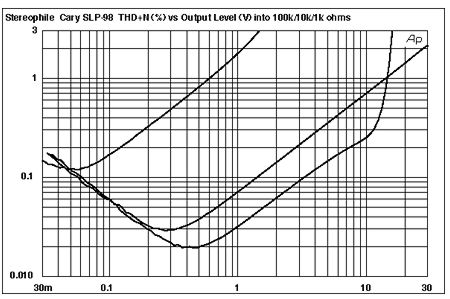
Fig.3 Cary SLP-98P, distortion (%) vs output voltage at 1kHz into (from bottom to top): 10k, 100k, 1k ohms.
Note that when the distortion starts to rise out of the noise, it is at a very low level: around 0.03% into 100k ohms, 0.02% into 10k ohms, which suggests that the Cary's output stage likes to see some current flowing to achieve its most linear behavior. Plotting the THD percentage against frequency (not shown) revealed that there was very little change in this distortion level, with only a slight rise above the audioband. In addition, as can be seen in fig.4, the spectrum of the distortion shows a linear decrease in level with increasing order, something that always correlates with good sound (though Jean Hiraga's work demonstrating this in the 1970s was performed with circuits not nearly as linear as the Cary's line stage). The actual THD level in this graph, by the way, ignoring the contribution of noise, was just 0.083%. Intermodulation, too, was respectably low, even into a low 8k ohm test load, with just 0.0015% of difference component produced by an equal mix of 19 and 10kHz tones (fig.5).
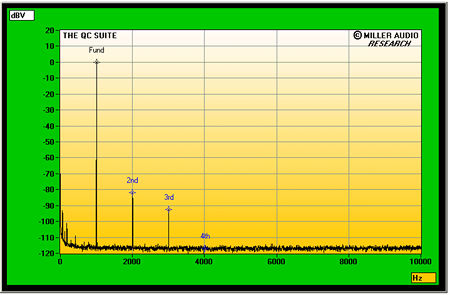
Fig.4 Cary SLP-98P, spectrum of 1kHz sinewave, DC-10kHz, at 1V into 8k ohms (linear frequency scale).
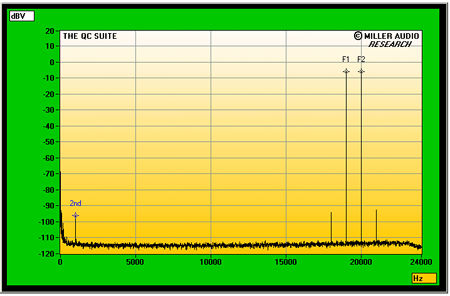
Fig.5 Cary SLP-98P, HF intermodulation spectrum, DC-24kHz, 19+20kHz at 1V into 8k ohms (linear frequency scale).
I would have liked to have seen a little more high-frequency headroom in the phono stage, but provided it is not used into impedances much lower than 10k ohms, Cary's SLP-98P offers excellent measured performance that is not compromised by its unabashed use of tubes.—John Atkinson
- Log in or register to post comments




































